Pore Structure and Fractal Characteristics of Continental Low Maturity Organic-Rich Shale in the Sha-4 Member of the Liaohe Western Depression
Abstract
:1. Introduction
2. Geological Setting
3. Samples and Experimental Methods
3.1. Sample Collection
3.2. Experimental Instruments and Lab Analysis
3.2.1. Total Organic Carbon Analysis
3.2.2. X-ray Diffraction Analysis
3.2.3. Vitrinite Reflectance (Ro%) Measurement
3.2.4. Nitrogen Adsorption Experiment
3.2.5. SEM Experiment
3.3. Calculation Model of Fractal Dimension
4. Results
4.1. Basic Characteristics of Shale
4.2. The Pore Structure Based on SEM
- Intergranular pore
- 2.
- Inter-crystalline pore
- 3.
- Dissolution pore
- 4.
- Microfracture
4.3. The Pore Structure Based on Nitrogen Adsorption
4.4. Fractal Dimension
5. Discussion
5.1. Pore Types and Pore Size Distribution Characteristics
5.2. Factors Influencing Pore Structure
5.3. Fractal Dimension and Pore Structure Relationship
5.4. Factors Influencing Fractal Dimension
6. Conclusions
- (1)
- The shales in the Liaohe Western Depression are characterized by high TOC, low maturity and high clay mineral content. They are mainly mesoporous. The main pore types are intergranular pores and inter-crystalline pores. The pore morphology is very irregular, mostly flat and slit-shaped. The pore structure of shales has obvious dual fractal characteristics and the pores with larger pore diameters have stronger heterogeneity.
- (2)
- The pore structure and fractal characteristics of continental low mature organic shale are affected by organic matter content. In continental low mature shale, a large amount of organic matter fills in the pores, affecting the pore structure. The higher the content of organic matter, the weaker the heterogeneity of pore structure and the lower the complexity.
- (3)
- Although clay minerals in continental shale can form a large number of micropores, they are filled with organic matter under low maturity conditions and the impact of compaction weakens the impact on pore structure and fractal characteristics of shale. Rigid minerals such as quartz can support and protect pores, provide space for organic matter filling and are not easy to dissolve under low mature conditions, reducing the heterogeneity of pore structure of low mature continental shale.
- (4)
- The influence of the sedimentary environment on the micropore structure of shale is specifically reflected in the difference in mineral components and the level of maturity, especially the influence of maturity, which controls the type of pore development in shale and also directly affects the role of organic matter in the genetic mechanism of shale microheterogeneity.
Author Contributions
Funding
Data Availability Statement
Conflicts of Interest
References
- Shao, X.H.; Pang, X.Q.; Hu, T.; Xu, T.W.; Xu, Y.; Tang, L.; Li, H.; Li, L.L. Microscopic characteristics of pores in Es-3 shales and its significances for hydrocarbon retention in Dongpu Sag, Bohai Bay Basin. Oil Gas Geol. 2019, 40, 67–77. [Google Scholar]
- Jarvie, D.M.; Hill, R.J.; Ruble, T.E.; Tim, E.R. Unconventional shale-gas systems:The Mississippian Barnett Shale of north-central Texas as one model for thermogenic shale-gas assessment. AAPG Bull. 2007, 91, 475–499. [Google Scholar] [CrossRef]
- Roger, M.S.; Neal, R.O. Pore types in the Barnett and Woodford gas shales:Contribution to understanding gas storage and migration pathways in fine-grained rocks. AAPG Bull. 2011, 95, 2017–2030. [Google Scholar]
- Chen, S.B. Study review on microstructure and adsorption heterogeneity of shale reservoir. Coal Sci. Technol. 2016, 44, 23–32. [Google Scholar] [CrossRef]
- Wang, H.; Shi, Y.M.; Xu, D.W.; Chen, X.; Li, L.M.C.D. Characterization techniques and progress of unconventional reservoir pore structure. Pet. Geol. Recovery Effic. 2019, 26, 21–30. [Google Scholar] [CrossRef]
- Cheristine, E.K. Fractal measurements of sandstones, shales, and carbonates. J. Geophys. Res. Solid Earth 1988, 93, 3297–3305. [Google Scholar]
- Xiong, J.; Liu, X.J.; Ling, L.X. Pore Structure and Fractal Characteristics of Longmaxi Formation Shale in the Changning Region of Sichuan Basin. Geol. Sci. Technol. Inf. 2015, 34, 70–77. [Google Scholar]
- Ji, W.M.; Song, Y.; Jiang, Z.X.; Meng, M.M.; Liu, Q.X.; Chen, L.; Wang, P.F.; Gao, F.L.; Huang, H.X. Fractal characteristics of nano-pores in the Lower Silurian Longmaxi shales from the Upper Yangtze Platform, south China. Mar. Pet. Geol. 2016, 78, 88–98. [Google Scholar] [CrossRef]
- Nie, W.C.; Zhang, T.S.; Wang, M.W.; Wu, W.; Tan, X.C. Fractal Characteristics and Interfering Factors of Microscopic pores in Marine-continental Transitional Coal Shale: A case study of the Taiyuan Formation in the northern Qinshui Basin. Acta Sedimentol. Sin. 2022, 78, 1000–0550. [Google Scholar]
- Yin, L.L.; Guo, S.B. Full-Sized Pore Structure and Fractal Characteristics of Marine-Continental Transitional Shale: A Case Study in Qinshui Basin, North China. Acta Geol. Sin.-Engl. Ed. 2019, 93, 675–691. [Google Scholar] [CrossRef]
- Sun, Y.S.; Guo, S.B. Qualitative and Quantitative Characterization of Shale Microscopic Pore Characteristics Based on Image Analysis Technology. Adv. Earth Sci. 2016, 31, 751–763. [Google Scholar]
- Li, X.G.; Chen, Y.C.; Li, Y.J.; Lan, K.; Li, J.H.; Gong, W.M. Petroleum Exploration History and Enlightenment of Liaohe Depression in Bohai Bay Basin. Xinjiang Pet. Geol. 2021, 42, 291–301. [Google Scholar]
- Liu, S.Q.; Jiang, Z.X.; Wang, X.B.; Chen, J.; Gao, Y.; Wu, M.H.; Sun, X.W.; Luan, T.S. Reservoir Characteristics and the Effect of Diagenesis on E2s4 Reservoir in the West Slope of West Depression, Liaohe Oilfield. Geoscience 2015, 29, 692–701. [Google Scholar]
- Ge, M.N.; Zhang, J.C.; Li, W.J.; Sun, R. Main controlling factors analysis of shale oil and gas accumulation in west sag of Liaohe depression. Pet. Geol. Eng. 2015, 29, 46–49+53+146. [Google Scholar]
- Yang, C.; Zhang, J.C.; Li, W.J.; Jing, T.Y.; Sun, R. Microscopic pore characteristics of Sha-3 and Sha-4 shale and their accumulation significance in Liaohe Depression. Oil Gas Geol. 2014, 35, 286–294. [Google Scholar]
- Shan, Y.S.; Zhang, J.C.; Li, X.G.; Bi, C.Q.; Tang, Y. Hydrocarbon enrichment conditions and distribution in continental shale, West Liaohe Sag, Bohai Bay Basin. Pet. Geol. Exp. 2016, 38, 496–501. [Google Scholar]
- Chen, C.; Jin, K.; Lei, W.W.; Wang, H.; Guo, F.; Qian, L.X.; Qin, X.C. High-precision Prediction of Thin Sandstones in Dujiatai Oil Layer of Shuguang Area. Spec. Oil Gas Reserv. 2020, 27, 96–101. [Google Scholar]
- Song, B.; Wang, B.; Liu, X.Z.; Liu, S.Z.; Chen, X.G.; Lu, W.Z. Genetic Types and Distribution Rules of Thin Sand Layers in the Fourth Member of Shahejie Formation in Shubei Area of the Western Sag, Liaohe Depression. Geol. Resour. 2021, 30, 698–706. [Google Scholar]
- Xue, S.H.; Luo, P.; Yang, Y.T.; Xu, T.G. Depositional systems and oil/gas distribution in the Liaohe Depression. Pet. Explor. Dev. 1997, 24, 19–22. [Google Scholar]
- Mao, J.L.; Jing, T.Y.; Han, X.; Shang, C.; Huang, S.Q.; Ma, M.X. Petrology types and organic geochemical characteristics of shale in the Western Depression, Liaohe. Earth Sci. Front. 2016, 23, 185–194. [Google Scholar]
- Ge, X.B.; Li, J.J.; Lu, S.F.; Chen, F.W.; Yang, D.X.; Wang, Q. Fractal characteristics of tight sandstone reservoir using mercury intrusion capillary pressure:a case of tight sandstone reservoir in Jizhong Depression. Lithol. Reserv. 2017, 29, 106–112. [Google Scholar]
- Liu, J.P.; Liu, D.X.; Hu, H.Y.; Qiao, P.F.; Wang, T.; Xie, Z.T.; Liu, L.H. Pore structure characteristics of marine continental transitional facies shale of Shanxi formation in the eastern margin of Ordos basin. China Sci. 2022, 17, 21–30. [Google Scholar]
- Liu, X.P.; Jin, Z.J.; Lai, J.; Fan, X.C.; Guan, M.; Shu, H.L.; Wang, G.C. Fractal behaviors of NMR saturated and centrifugal T2 spectra in oil shale reservoirs: The Paleogene Funing formation in Subei basin, China. Mar. Pet. Geol. 2021, 129, 105069. [Google Scholar] [CrossRef]
- Liu, K.Q.; Ostadhassan, M.; Kong, L.Y. Fractal and Multifractal Characteristics of Pore Throats in the Bakken Shale. Transp. Porous Media 2019, 126, 579–598. [Google Scholar] [CrossRef]
- Liu, K.Q.; Ostandhassan, M.; Jang, H.W.; Zakharova, N.V.; Shokouhimehr, M. Comparison of fractal dimensions from nitrogen adsorption data in shale via different models. RSC Adv. 2021, 11, 2298–2306. [Google Scholar] [CrossRef]
- Li, Z.Q.; Wang, W.; Wang, X.M.; Bai, Y.W.; Qin, D.T.; Zhao, Y. Study on fractal characteristics of micro-nano pore structure of shale. J. Eng. Geol. 2018, 26, 494–503. [Google Scholar]
- Zhu, H.Q.; Jia, A.L.; Wei, Y.S.; Jia, C.Y.; Yuan, H. Microscopic Pore Structure and Fractal Characteristics of Wufeng-Longmaxi Shale, South Sichuan. Sci. Technol. Eng. 2018, 18, 12–19. [Google Scholar]
- Matthias, T.; Katsumi, K.; Alexander, V.N.; James, P.O.; Francisco, R.-R.; Jean, R.; Kenneth, S.W.S. Physisorption of gases, with special reference to the evaluation of surface area and pore size distribution(IUPAC Technical Report). Pure Appl. Chem. 2015, 87, 1051–1069. [Google Scholar]
- Wang, M.; Xue, H.T.; Tian, S.S.; Ronald, W.T.W.; Wang, Z.W. Fractal characteristics of Upper Cretaceous lacustrine shale from the Songliao Basin, NE China. Mar. Pet. Geol. 2015, 67, 144–153. [Google Scholar] [CrossRef]
- Yang, F.; Ning, Z.F.; Wang, Q.; Kong, D.T.; Peng, K.; Xiao, L.F. Fractal Characteristics of Nanopore in Shales. Nat. Gas Geosci. 2014, 25, 618–623. [Google Scholar]
- Chang, J.Q.; Fan, X.D.; Jiang, Z.X.; Wang, X.M.; Chen, L.; Li, J.T.; Zhu, L.; Wan, C.X.; Chen, Z.X. Differential impact of clay minerals and organic matter on pore structure and its fractal characteristics of marine and continental shales in China. Appl. Clay Sci. 2022, 216, 106334. [Google Scholar] [CrossRef]
- Guo, Y.; Zhao, D.F. Study on micro-heterogeneity of marine shale reservoir in micro scale. J. China Univ. Min. Technol. 2015, 44, 300–307. [Google Scholar]
- Ma, M.; Chen, G.J.; Xu, Y.; Hu, S.J.; Lv, C.F.; Xue, L.H. Fractal characteristics of pore structure of continental shale in the process of thermal evolution. Coal Geol. Explor. 2017, 45, 41–47. [Google Scholar]
- Hou, H.h.; Shao, L.y.; Li, Y.H.; Li, Z.; Zhang, W.L.; Wen, H.J. The pore structure and fractal characteristics of shales with low thermal maturity from the Yuqia Coalfield, northern Qaidam Basin, northwestern China. Front. Earth Sci. 2018, 12, 148–159. [Google Scholar] [CrossRef]
- Fu, J.j.; Guo, S.B.; Gao, Q.F.; Yang, J. Reservoir characteristics and enrichment conditions of shale gas in the Carboniferous-Permian coal-bearing formations of Qinshui Basin. Earth Sci. Front. 2016, 23, 167–175. [Google Scholar]
- Song, Y.; Gao, F.l.; Tang, X.L.; Chen, L.; Wang, X.M. Influencing factors of pore structure differences between marine and terrestrial shale reservoirs. Acta Pet. Sin. 2020, 41, 1501–1512. [Google Scholar]

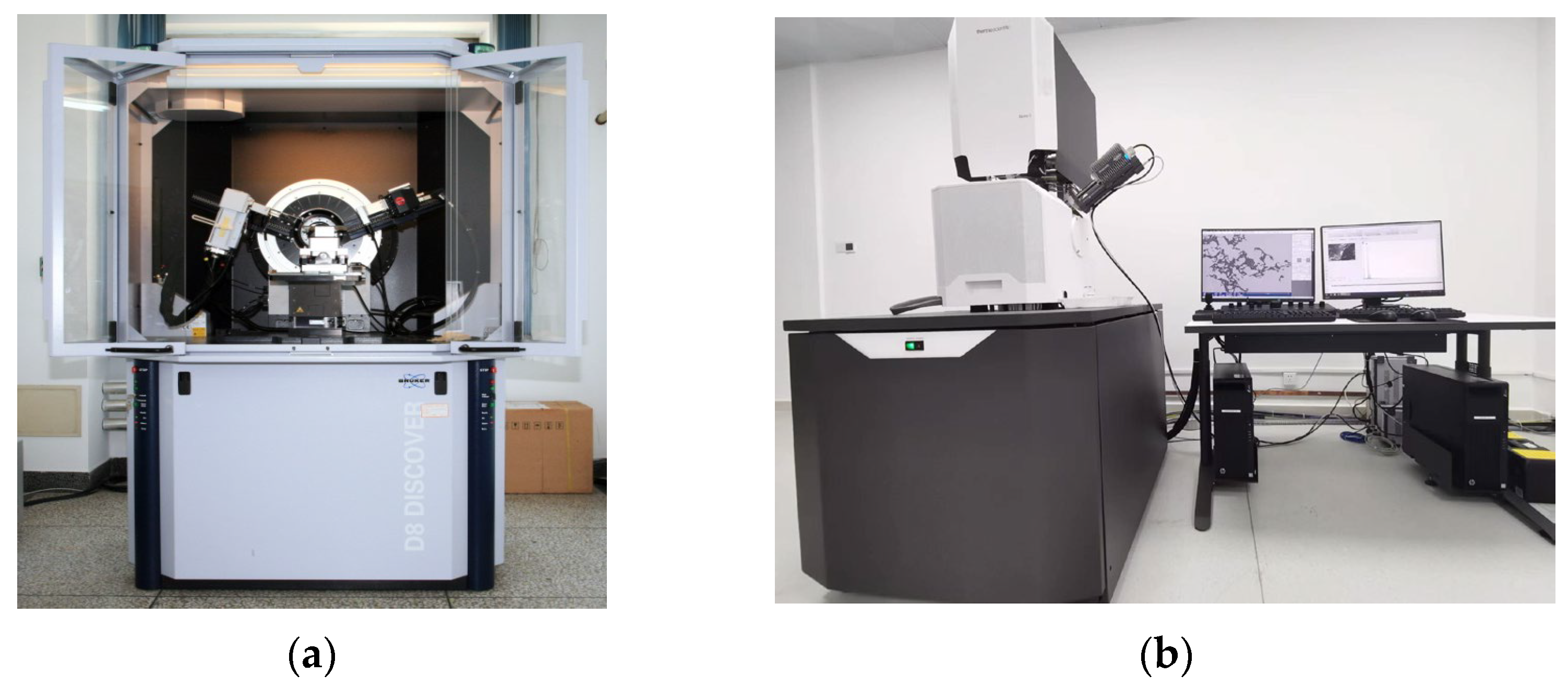
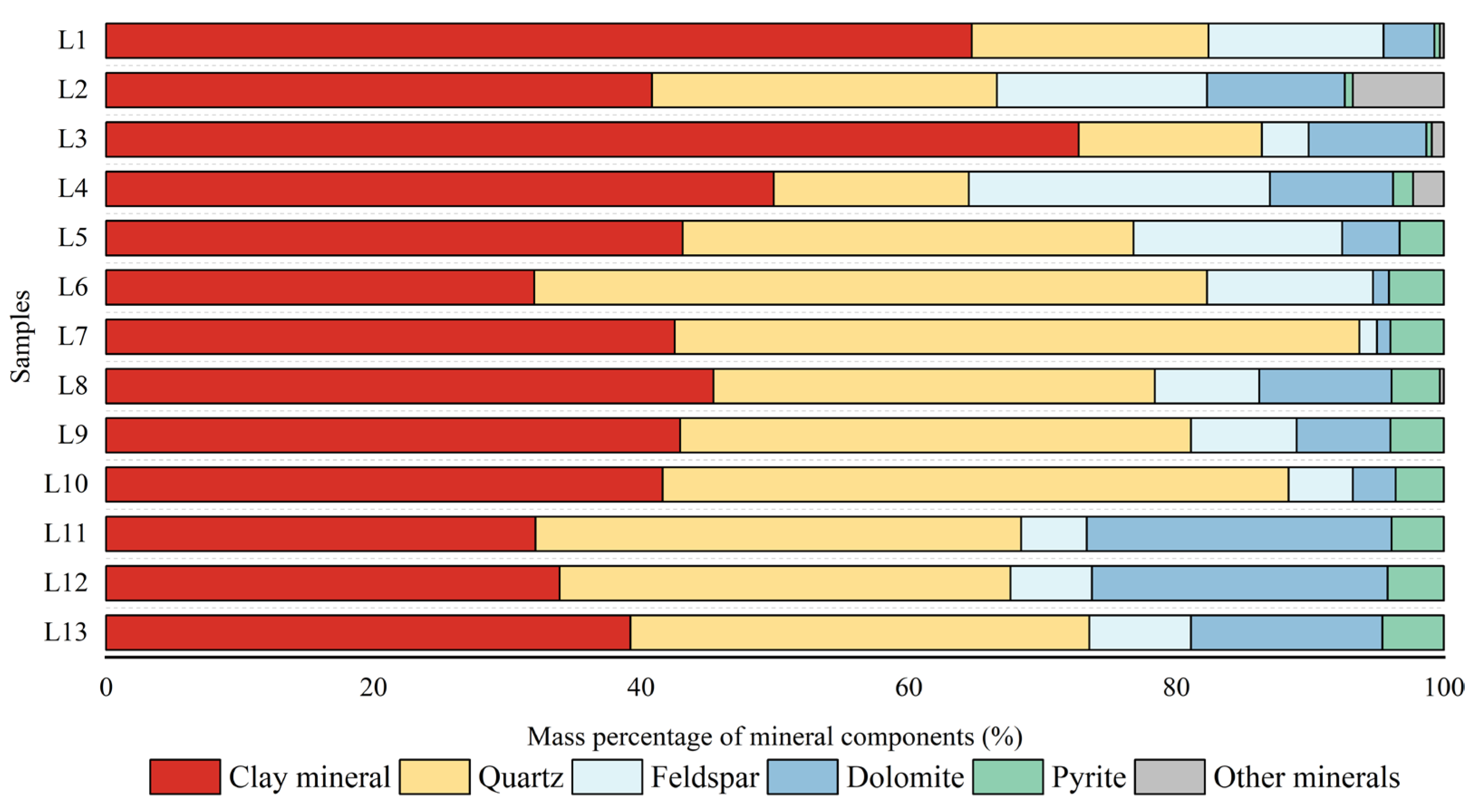
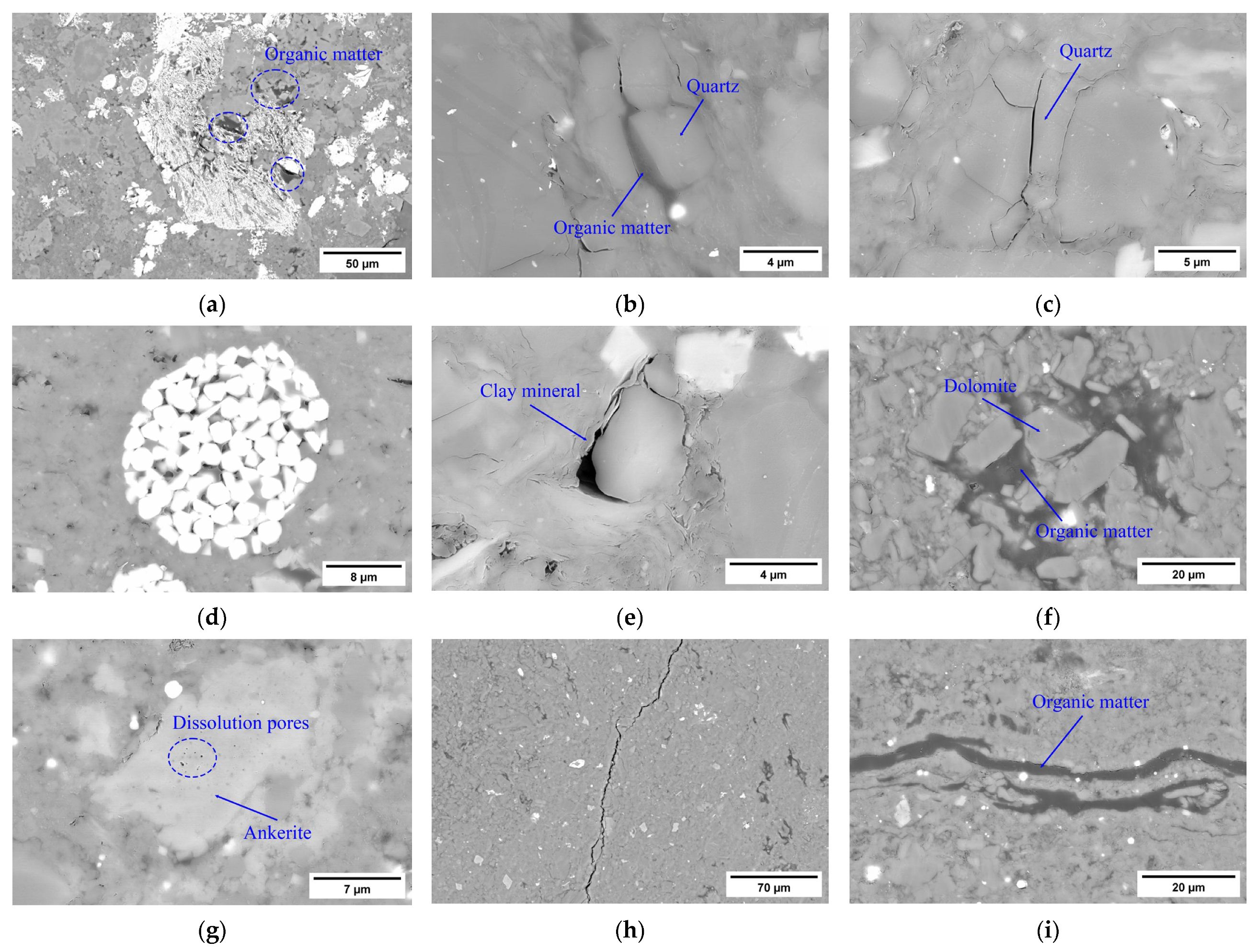


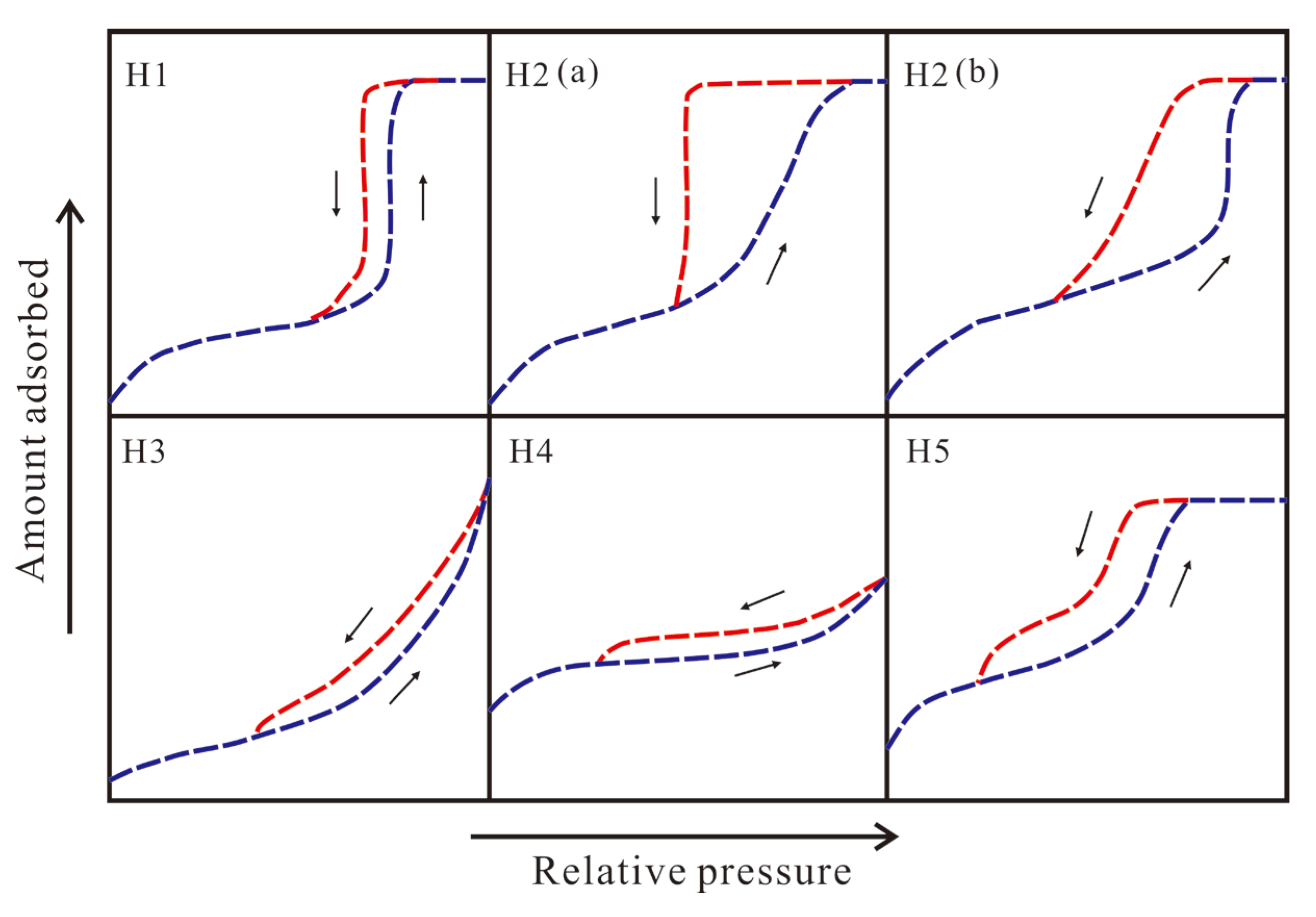
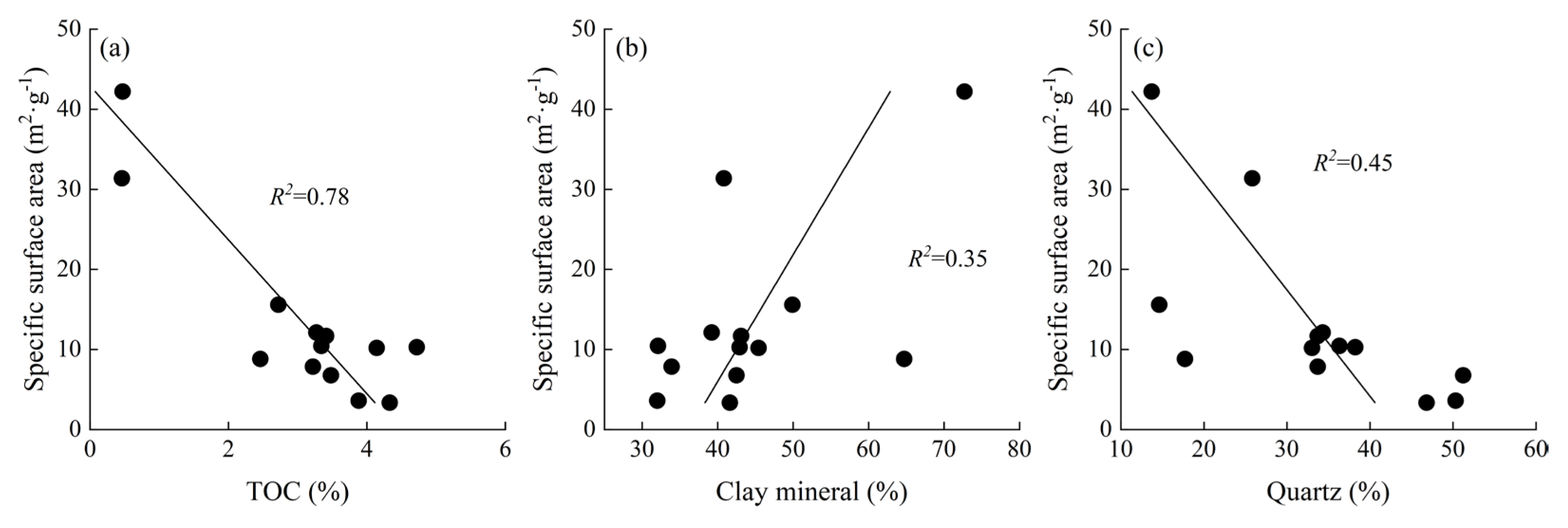


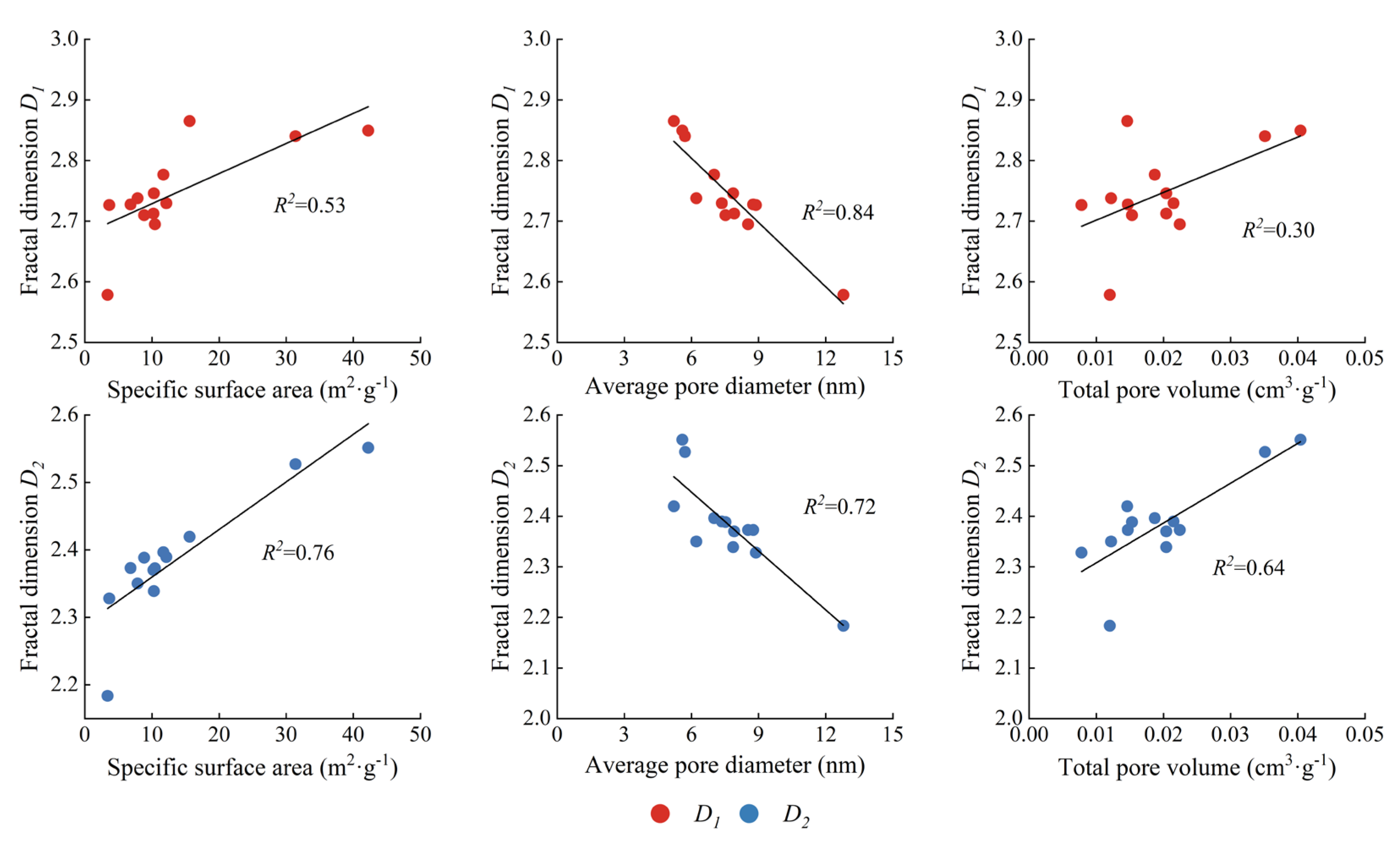
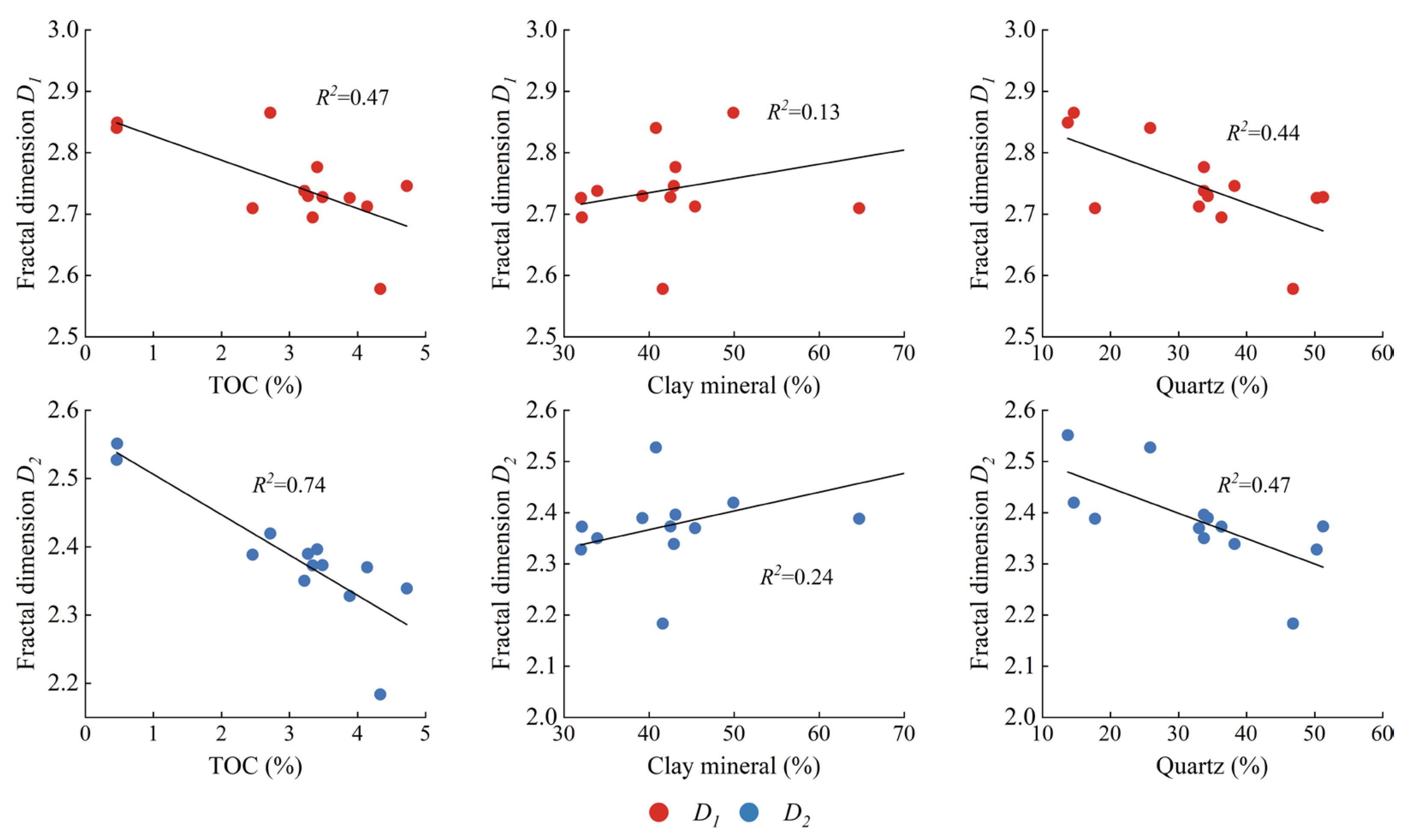
| Samples | TOC (%) | Ro (%) | Lithology |
|---|---|---|---|
| L1 | 2.46 | 0.45 | Mudstone |
| L2 | 0.46 | 0.38 | Silty mudstone |
| L3 | 0.47 | 0.38 | Mudstone |
| L4 | 2.72 | 0.37 | Mudstone |
| L5 | 3.41 | Shale | |
| L6 | 3.88 | Silty mudstone | |
| L7 | 3.48 | Shale | |
| L8 | 4.14 | Dolomitic mudstone | |
| L9 | 4.72 | Shale | |
| L10 | 4.33 | 0.46 | Silty mudstone |
| L11 | 3.34 | Dolomitic mudstone | |
| L12 | 3.22 | Dolomitic mudstone | |
| L13 | 3.27 | Dolomitic mudstone |
| Samples | Specific Surface Area (m2·g−1) | Average Pore Diameter (nm) | Total Pore Volume (cm3·g−1) |
|---|---|---|---|
| L1 | 8.8289 | 7.5153 | 0.0153 |
| L2 | 31.3820 | 5.7121 | 0.0351 |
| L3 | 42.2139 | 5.5876 | 0.0404 |
| L4 | 15.6083 | 5.2087 | 0.0146 |
| L5 | 11.7083 | 7.0119 | 0.0187 |
| L6 | 3.6219 | 8.8733 | 0.0078 |
| L7 | 6.7976 | 8.7588 | 0.0147 |
| L8 | 10.2120 | 7.9057 | 0.0204 |
| L9 | 10.2930 | 7.8625 | 0.0204 |
| L10 | 3.3829 | 12.7806 | 0.0120 |
| L11 | 10.4524 | 8.5238 | 0.0224 |
| L12 | 7.8650 | 6.2164 | 0.0122 |
| L13 | 12.1300 | 7.3528 | 0.0215 |
| Samples | High Specific Pressure (0.46 < P/P0 < 1) | Low Specific Pressure (0 < P/P0 < 0.46) | ||||
|---|---|---|---|---|---|---|
| K | R2 | D1 | K | R2 | D2 | |
| L1 | −0.29 | 0.95 | 2.71 | −0.61 | 0.97 | 2.39 |
| L2 | −0.16 | 0.92 | 2.84 | −0.47 | 0.99 | 2.53 |
| L3 | −0.15 | 0.96 | 2.85 | −0.45 | 0.99 | 2.55 |
| L4 | −0.13 | 0.97 | 2.8 | −0.58 | 0.96 | 2.42 |
| L5 | −0.22 | 0.94 | 2.78 | −0.60 | 0.98 | 2.40 |
| L6 | −0.27 | 0.95 | 2.73 | −0.67 | 0.97 | 2.33 |
| L7 | −0.27 | 0.95 | 2.73 | −0.63 | 0.98 | 2.37 |
| L8 | −0.29 | 0.97 | 2.71 | −0.63 | 0.99 | 2.37 |
| L9 | −0.25 | 0.94 | 2.75 | −0.66 | 0.98 | 2.34 |
| L10 | −0.42 | 0.98 | 2.58 | −0.82 | 0.97 | 2.18 |
| L11 | −0.31 | 0.98 | 2.69 | −0.63 | 0.99 | 2.37 |
| L12 | −0.26 | 0.95 | 2.74 | −0.65 | 0.98 | 2.35 |
| L13 | −0.27 | 0.98 | 2.73 | −0.61 | 0.99 | 2.39 |
Disclaimer/Publisher’s Note: The statements, opinions and data contained in all publications are solely those of the individual author(s) and contributor(s) and not of MDPI and/or the editor(s). MDPI and/or the editor(s) disclaim responsibility for any injury to people or property resulting from any ideas, methods, instructions or products referred to in the content. |
© 2022 by the authors. Licensee MDPI, Basel, Switzerland. This article is an open access article distributed under the terms and conditions of the Creative Commons Attribution (CC BY) license (https://creativecommons.org/licenses/by/4.0/).
Share and Cite
Liu, Y.; Zhang, L.; Zhang, X.; He, X.; Li, J.; Xing, Y.; Jin, F.; Wang, Y. Pore Structure and Fractal Characteristics of Continental Low Maturity Organic-Rich Shale in the Sha-4 Member of the Liaohe Western Depression. Energies 2023, 16, 327. https://doi.org/10.3390/en16010327
Liu Y, Zhang L, Zhang X, He X, Li J, Xing Y, Jin F, Wang Y. Pore Structure and Fractal Characteristics of Continental Low Maturity Organic-Rich Shale in the Sha-4 Member of the Liaohe Western Depression. Energies. 2023; 16(1):327. https://doi.org/10.3390/en16010327
Chicago/Turabian StyleLiu, Yinglin, Lei Zhang, Xuejuan Zhang, Xin He, Jinpeng Li, Yabing Xing, Fuxin Jin, and Yiran Wang. 2023. "Pore Structure and Fractal Characteristics of Continental Low Maturity Organic-Rich Shale in the Sha-4 Member of the Liaohe Western Depression" Energies 16, no. 1: 327. https://doi.org/10.3390/en16010327
APA StyleLiu, Y., Zhang, L., Zhang, X., He, X., Li, J., Xing, Y., Jin, F., & Wang, Y. (2023). Pore Structure and Fractal Characteristics of Continental Low Maturity Organic-Rich Shale in the Sha-4 Member of the Liaohe Western Depression. Energies, 16(1), 327. https://doi.org/10.3390/en16010327







